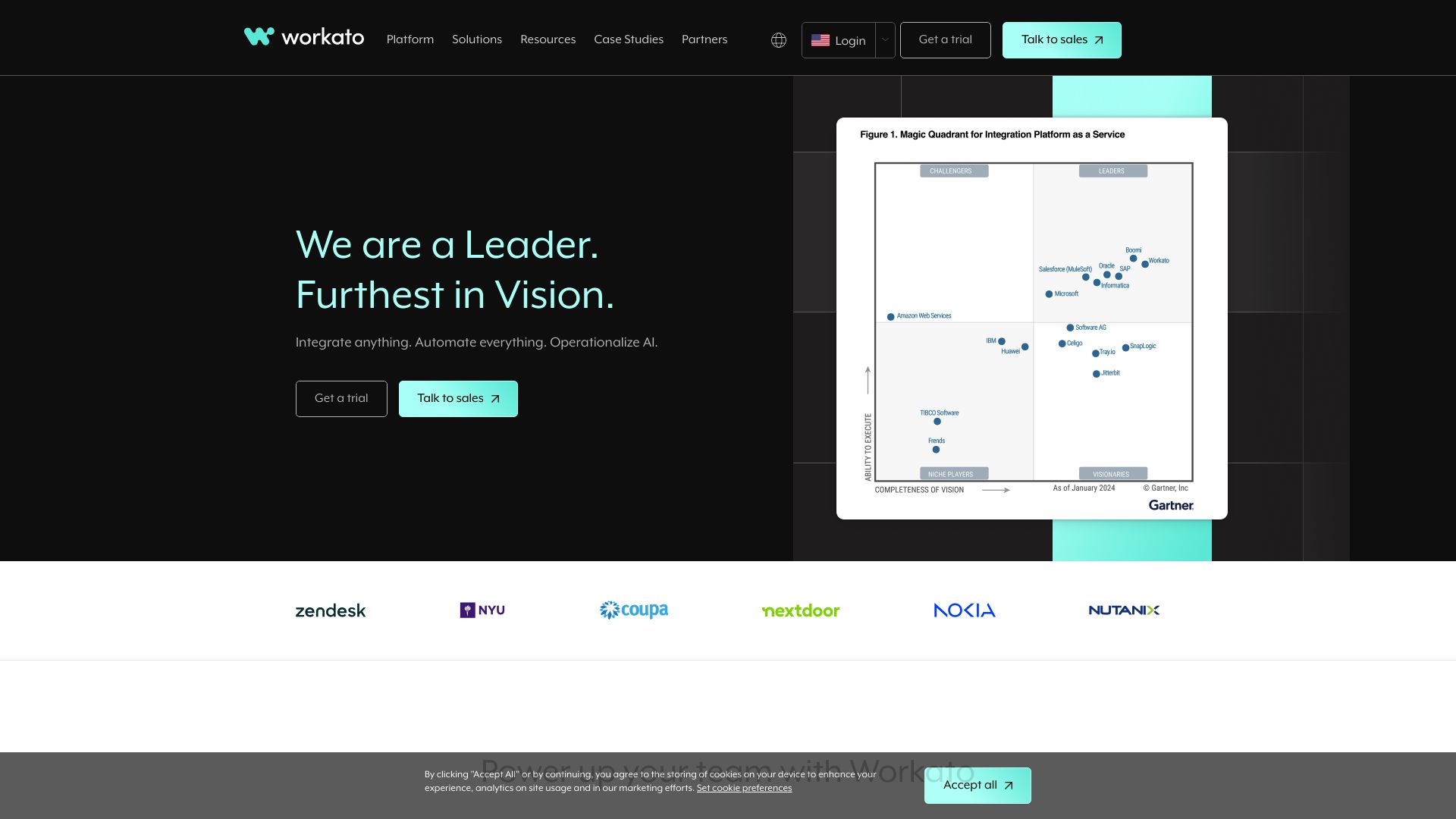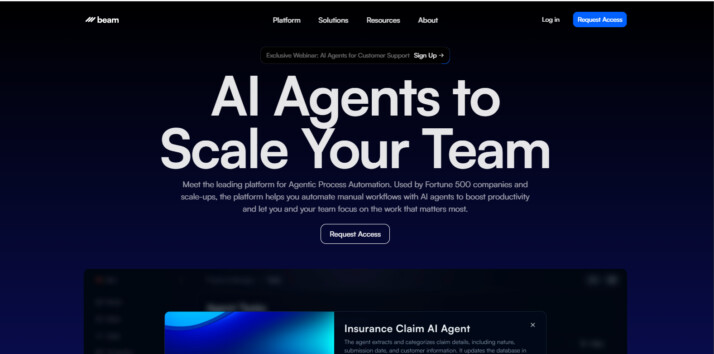Workato vs. Beam AI: AI-Powered Automation Showdown
AI-powered automation platforms are revolutionizing how businesses streamline operations and boost productivity. This review compares Workato vs. Beam AI, and SmythOS, three leading solutions in the field. We’ll explore their unique approaches to workflow automation, AI integration, and enterprise-grade features.
Whether you’re a developer seeking powerful APIs, a business leader focused on scalability, or a non-technical user looking for intuitive tools, this comparison will help you navigate the landscape of AI automation. Discover how each platform tackles complex workflows, learns from data, and empowers users to create sophisticated automations without extensive coding. By the end, you’ll have a clear understanding of which solution best aligns with your organization’s needs and automation goals.
Workato Overview
Workato empowers businesses to automate complex workflows and integrate diverse applications without extensive coding. This low-code/no-code platform combines robust automation capabilities with AI-driven features, making it accessible to both technical and non-technical users.


Workato’s AI by Workato, developed in collaboration with OpenAI, integrates AI models into workflows without compromising data privacy. Users can leverage AI for tasks like text analysis, email drafting, and language translation. The platform’s drag-and-drop interface simplifies the creation of sophisticated automations, while pre-built connectors and community recipes accelerate development.
Workato’s AI by Workato, developed in collaboration with OpenAI, integrates AI models into workflows without compromising data privacy.
Enterprise-grade features set Workato apart. The platform scales to handle complex business needs, offering robust security, governance, and compliance capabilities. This makes it particularly attractive for large organizations with intricate automation requirements. Workato also provides environments for development, testing, and production, ensuring smooth transitions from concept to deployment.
Despite its strengths, Workato faces some limitations. The platform’s extensive feature set can initially overwhelm new users. Additionally, the AI capabilities come with usage limits, potentially constraining high-volume applications. Cost may also be a concern for smaller businesses or those with tight budgets, as enterprise-level functionality often comes at a premium.
Workato’s vision centers on democratizing automation and integration technologies. By combining AI capabilities with user-friendly tools, the platform aims to empower businesses of all sizes to streamline operations, boost productivity, and deliver enhanced customer experiences. As AI continues to reshape the business landscape, Workato positions itself as a key player in helping organizations harness this transformative technology.
Beam AI Overview
Beam AI specializes in developing generative AI agents that automate repetitive manual tasks for organizations. Their Agentic Process Automations (APAs) perform tasks faster and more cost-effectively than humans, covering areas like data extraction, customer inquiry management, compliance automation, and order optimization.


Beam AI’s agents continuously learn and adapt, enhancing precision and efficiency over time. The platform focuses on back-office automation, customer service, compliance, and order processing, with solutions tailored to specific organizational needs. Beam AI emphasizes sustainability, aiming to minimize steps and reduce human carbon footprint in business processes.
Beam AI’s agents continuously learn and adapt, enhancing precision and efficiency over time.
The company’s AI-native approach integrates advanced conversational interfaces, allowing seamless interaction and efficient task management. Beam AI agents can integrate with existing internal systems to plan and execute workflows, providing comprehensive automation solutions. This capability enables businesses to streamline operations and focus on higher-value tasks.
While Beam AI offers powerful automation capabilities, it may have limitations in certain areas. The platform’s focus on specific use cases like back-office tasks and customer service could potentially limit its applicability in more specialized or niche industries. Additionally, the continuous learning aspect of the agents, while beneficial, might require ongoing monitoring and adjustment to ensure alignment with changing business needs and compliance requirements.
Beam AI’s vision centers on creating a sustainable and ethical future using AI. Their mission to build AI agents capable of tackling complex workflows and improving over time through continuous learning and adaptation positions them as a forward-thinking player in the AI automation space. However, potential users should carefully evaluate whether Beam AI’s specific focus areas align with their unique business requirements and long-term automation strategies.
Feature Comparison
Workato and Beam AI offer distinct approaches to AI-driven automation, each with unique strengths and limitations. Workato excels in providing a comprehensive low-code/no-code platform for enterprise-level workflow automation and integration. Its visual builder and pre-built connectors enable users to create complex automations without extensive coding knowledge. Workato’s AI capabilities, developed in collaboration with OpenAI, allow for seamless integration of AI models into workflows.
In contrast, Beam AI focuses specifically on generative AI agents for task automation. Beam’s Agentic Process Automations (APAs) are designed to handle repetitive manual tasks autonomously, with a particular emphasis on back-office operations, customer service, and compliance. Unlike Workato’s broader integration platform, Beam AI specializes in creating AI agents that continuously learn and adapt to improve efficiency over time.
A key difference lies in their approach to AI implementation. While Workato integrates AI capabilities into its existing automation platform, Beam AI builds its entire solution around AI-native agents. This distinction impacts how each platform handles tasks like memory and context management, with Beam AI potentially offering more advanced capabilities in this area. However, Workato’s extensive integration ecosystem and enterprise-grade features may provide greater flexibility for organizations with complex, multi-system environments.
Feature Comparison Table
| Workato | Beam AI | SmythOS | |
|---|---|---|---|
| CORE FEATURES | |||
| Visual Builder | ✅ | ❌ | ✅ |
| No-Code Options | ✅ | ❌ | ✅ |
| Autonomous Agents | ❌ | ✅ | ✅ |
| Debug Tools | ✅ | ❌ | ✅ |
| Multimodal | ❌ | ❌ | ✅ |
| Multi-Agent Collaboration | ❌ | ✅ | ✅ |
| SECURITY | |||
| Constrained Alignment | ❌ | ✅ | ✅ |
| COMPONENTS | |||
| Huggingface AIs | ❌ | ✅ | ✅ |
| Zapier APIs | ❌ | ✅ | ✅ |
| Data Lakes | ❌ | ❌ | ✅ |
| DEPLOYMENT OPTIONS (EMBODIMENTS) | |||
| DATA LAKE SUPPORT | |||
| Hosted Vector Database | ❌ | ❌ | ✅ |
| Sitemap Crawler | ❌ | ❌ | ✅ |
| YouTube Transcript Crawler | ❌ | ❌ | ✅ |
| URL Crawler | ❌ | ❌ | ✅ |
Best Alternative to Workato and Beam AI
SmythOS stands out as the superior alternative to Workato and Beam AI, offering a comprehensive AI automation platform that combines the best of both worlds. Our platform delivers unparalleled flexibility, ease of use, and a rich feature set that empowers users to create sophisticated AI agents for virtually unlimited use cases.
Unlike Workato’s focus on enterprise workflow automation or Beam AI’s specialized generative AI agents, SmythOS provides a versatile foundation for building and deploying AI solutions across various domains. We offer a visual builder that surpasses Workato’s in terms of intuitiveness, allowing users to create complex AI workflows without extensive coding knowledge. This approach democratizes AI development, making it accessible to a broader audience while still providing the depth of functionality that advanced users require.
While Beam AI excels in creating autonomous agents for specific tasks, SmythOS takes this concept further by enabling multi-agent collaboration and offering a wider range of deployment options. Our platform supports autonomous agents that can work together seamlessly, tackling complex problems that would be challenging for single-agent systems. This collaborative capability, combined with our extensive integration ecosystem, allows for the creation of more sophisticated and adaptable AI solutions.
SmythOS provides a versatile foundation for building and deploying AI solutions across various domains. We offer a visual builder that surpasses Workato’s in terms of intuitiveness…
SmythOS also addresses key limitations found in both Workato and Beam AI. Unlike Workato’s AI capabilities, which are subject to rate limits and lack granular permissions, we provide unrestricted access to AI functionalities and robust security features. Our platform offers advanced memory and context management, surpassing Beam AI’s capabilities in this area. Additionally, SmythOS includes features like a hosted vector database, sitemap crawlers, and support for various file formats, providing a more comprehensive toolkit for data handling and processing.
By choosing SmythOS, users gain access to a cutting-edge AI platform that combines the strengths of workflow automation and specialized AI agents while offering unique advantages in terms of flexibility, scalability, and ease of use. Our solution empowers organizations to harness the full potential of AI across a wide range of applications, from customer service and back-office automation to complex data analysis and decision-making processes.
Conclusion
Workato and Beam AI offer powerful automation solutions, each with unique strengths. Workato excels in providing a comprehensive low-code/no-code platform for enterprise-level workflow automation, while Beam AI focuses on specialized AI agents for task automation. Both platforms demonstrate the growing importance of AI in streamlining business processes.
However, SmythOS emerges as the superior choice, combining the best of both worlds and pushing the boundaries of AI-powered automation. Our platform offers unparalleled flexibility with its drag-and-drop interface, extensive integration ecosystem, and support for multiple AI models. SmythOS enables users to create sophisticated multi-agent systems that can tackle complex tasks across various industries.
Unlike Workato and Beam AI, SmythOS provides a truly versatile ’Create Once, Deploy Anywhere’ approach. This allows businesses to seamlessly integrate AI agents into their existing workflows, whether as APIs, chatbots, or scheduled tasks. Our platform’s ability to support over 300,000 integrations far surpasses the capabilities of both Workato and Beam AI, offering unmatched flexibility and scalability.
Experience the future of AI-powered automation with SmythOS. Explore our diverse range of AI-powered agent templates to jumpstart your productivity, or create a free account to start building your own AI agents today. With SmythOS, you’re not just automating tasks – you’re revolutionizing your entire workflow.
Last updated:
Disclaimer: The information presented in this article is for general informational purposes only and is provided as is. While we strive to keep the content up-to-date and accurate, we make no representations or warranties of any kind, express or implied, about the completeness, accuracy, reliability, suitability, or availability of the information contained in this article.
Any reliance you place on such information is strictly at your own risk. We reserve the right to make additions, deletions, or modifications to the contents of this article at any time without prior notice.
In no event will we be liable for any loss or damage including without limitation, indirect or consequential loss or damage, or any loss or damage whatsoever arising from loss of data, profits, or any other loss not specified herein arising out of, or in connection with, the use of this article.
Despite our best efforts, this article may contain oversights, errors, or omissions. If you notice any inaccuracies or have concerns about the content, please report them through our content feedback form. Your input helps us maintain the quality and reliability of our information.
